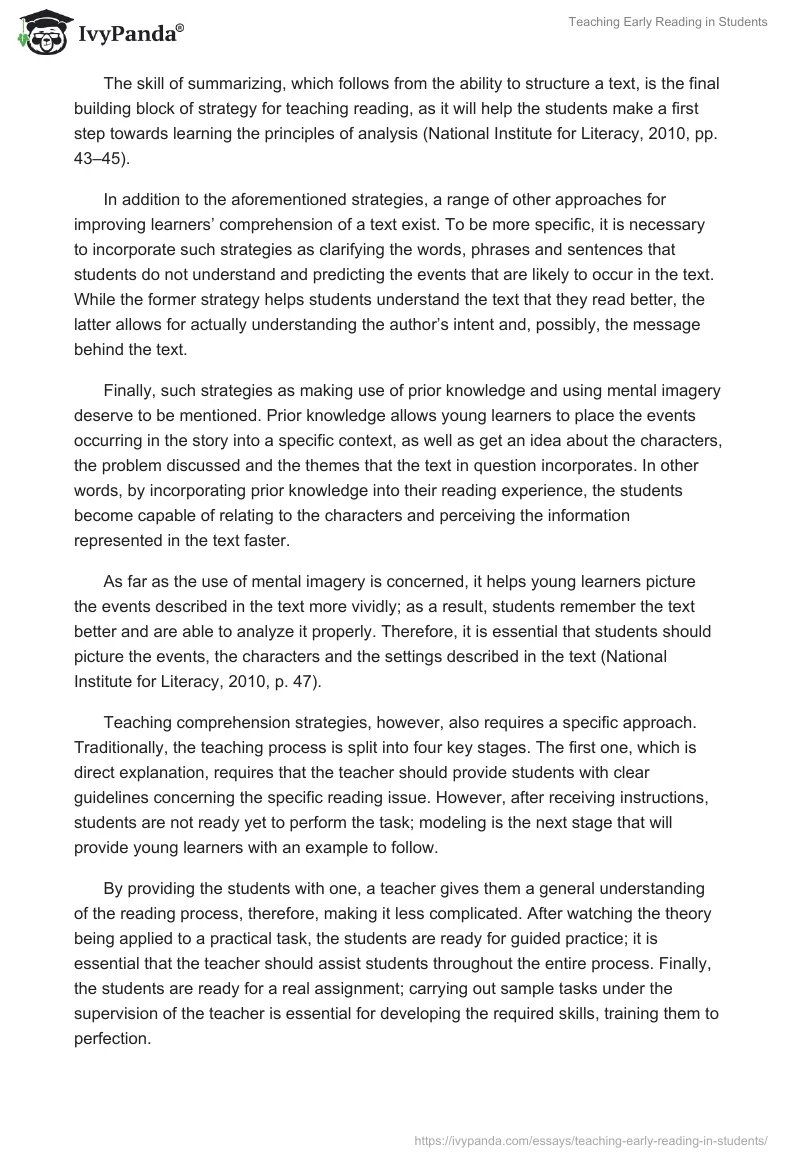There are six basic teaching strategies that enhance the process of learning to read. Monitoring comprehension is the first and the most important step towards a successful learning process. For a student, the application of the monitoring comprehension entails the recognition of the issues that they understand, as well as the ones that they do not understand. As a result, the student becomes capable of using an appropriate “fix-up” strategy to address certain gaps in their knowledge and understanding.
The use of visual aids and graphic organizers is also of huge essence. Since the process of reading is two-fold, i.e., it requires the analysis of both the visual and the audio data, it is crucial that children should learn to translate letters and their combinations into sounds, which pictures and graphs will help in.
Visual aids will allow students understand specific rules rather than learn them by heart. The use of graphic organizers allows for helping students understand the way in which a text is structured and, therefore, learn the basic methods of telling a story.
When it comes to the two essential strategies, asking and generating questions is obviously the key towards mastering reading. The more students learn, the more questions they have; therefore, a good teacher must create the environment, which would make students curious about certain aspects of reading.
Asking questions enables students to identify the key ideas conveyed in the text, as well as to analyze and synthesize texts in order to identify the tools that the author uses to get the message across. Generating questions, in its turn, enables students for reading in general; moreover, by generating questions, students engage into active thinking in the course of the reading process, therefore, improving their comprehension process.
Finally, the ability to identify the structure of a story is an essential skill that a reading instructor must teach students. Recognizing the story structure entails a greater appreciation and a better memory for stories among students (National Institute for Literacy, 2010, p. 44).
The skill of summarizing, which follows from the ability to structure a text, is the final building block of strategy for teaching reading, as it will help the students make a first step towards learning the principles of analysis (National Institute for Literacy, 2010, pp. 43–45).
In addition to the aforementioned strategies, a range of other approaches for improving learners’ comprehension of a text exist. To be more specific, it is necessary to incorporate such strategies as clarifying the words, phrases and sentences that students do not understand and predicting the events that are likely to occur in the text. While the former strategy helps students understand the text that they read better, the latter allows for actually understanding the author’s intent and, possibly, the message behind the text.
Finally, such strategies as making use of prior knowledge and using mental imagery deserve to be mentioned. Prior knowledge allows young learners to place the events occurring in the story into a specific context, as well as get an idea about the characters, the problem discussed and the themes that the text in question incorporates. In other words, by incorporating prior knowledge into their reading experience, the students become capable of relating to the characters and perceiving the information represented in the text faster.
As far as the use of mental imagery is concerned, it helps young learners picture the events described in the text more vividly; as a result, students remember the text better and are able to analyze it properly. Therefore, it is essential that students should picture the events, the characters and the settings described in the text (National Institute for Literacy, 2010, p. 47).
Teaching comprehension strategies, however, also requires a specific approach. Traditionally, the teaching process is split into four key stages. The first one, which is direct explanation, requires that the teacher should provide students with clear guidelines concerning the specific reading issue. However, after receiving instructions, students are not ready yet to perform the task; modeling is the next stage that will provide young learners with an example to follow.
By providing the students with one, a teacher gives them a general understanding of the reading process, therefore, making it less complicated. After watching the theory being applied to a practical task, the students are ready for guided practice; it is essential that the teacher should assist students throughout the entire process. Finally, the students are ready for a real assignment; carrying out sample tasks under the supervision of the teacher is essential for developing the required skills, training them to perfection.
Apart from the specified methods, metacognition and summarizing can be viewed as essential strategies for teaching comprehension. Summarizing allows students to understand the principles of text structuring, while metacognition will provide a look at the process of learning, thus, helping the students navigate the latter. Apart from the specified approaches, Systematic and explicit phonics instruction, monitored oral reading, choral reading, tape-assisted reading and partner reading and specific word instruction must be mentioned.
Moreover, teaching phonemic awareness should be listed among the key strategies, as it leads to reading comprehension in students. The strategies that encourage reading fluency also affect the learners’ reading comprehension to a considerable degree. Though fluency does presuppose recognizing words automatically, at the same time it helps locate the words and define their meaning faster within the context of a specific discourse.
Repeated and monitored oral reading is traditionally suggested as the best strategy for improving reading comprehension (National Institute for Literacy, 2010, p. 20). Finally, encouraging the students to re-read texts on their own in order to memorize the lessons learned during the class time can be viewed as an essential strategy for fostering reading comprehension.
Reference List
National Institute for Literacy. (2010). Put reading first. Web.


